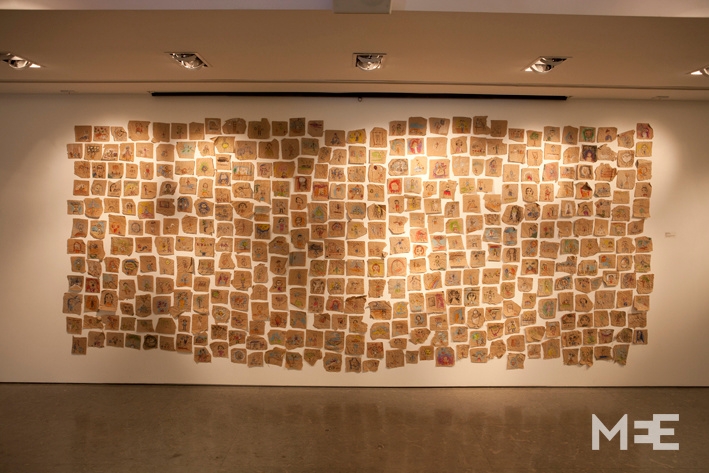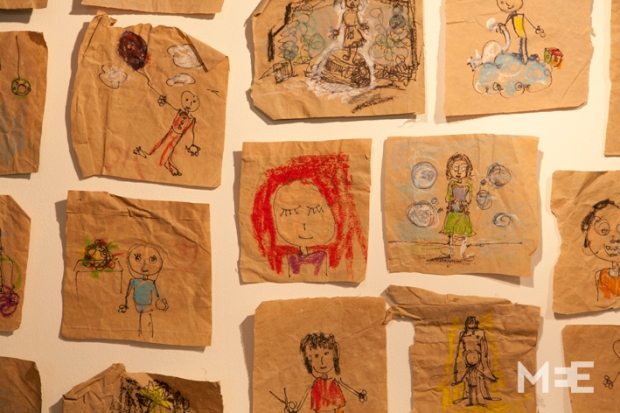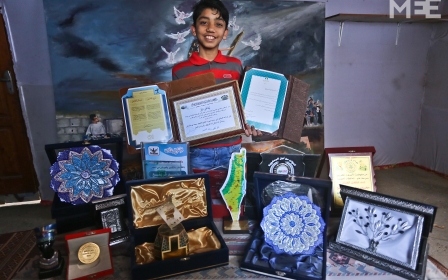Gaza on Gaza - Their stories through art

Despite the expectant crowd gathered at the gallery in central London to attend the opening of the Gaza on Gaza exhibition, the absence of the artists loomed over the event as a poignant reminder of the blockade under which many Palestinians live.
Unlike their creators, the pieces reached the P21 Gallery, a quiet space a few steps away from hectic Kings Cross, where they will show, until the end of August, the artists’ reactions to last year’s bombings.
According to UN figures, in the 51-day operation 1483 Palestinian civilians were killed, a third of them children, and more than 500,000 people were displaced. One year on, more than 300,000 children require psycho-social support to cope with the traumatic experience and none of the 18,000 houses that were destroyed or severely damaged have been rebuilt, leaving 100,000 people unable to go back to their homes.
Inevitably, the conflict filters through to the work being exhibited in London. The central piece of the show is the installation If I Wasn’t There by Majdal Nateel, a collection of 400 small paintings that represent the lost dreams and hopes of the children who died during the attacks.
Using a childlike painting style, the artist has created simple images to voice simple wishes that were silenced by the bombs.
The scale of the installation draws the viewer towards the individual messages and invites them to play the game: If I hadn’t been there I would be flying my kite. If I hadn’t been there I would be at school, or baking a cake, or playing the guitar…
Nateel helped with psychological intervention sessions for children evacuated from devastated areas during last summer’s war. As an artist inspired by life experience and as a mother of two young girls, she felt compelled to do something to "draw the international community’s attention to Israeli assaults and violations against the people of Gaza including children" and also "to the Palestinian children’s suffering due to the lack of stability and political crisis," Nateel explained from Gaza by email.
Even the canvases used for the paintings constitute a political stance. They are made of pieces torn from the cement bags that were distributed among people who had lost their homes during the airstrikes. Nateel and her family had to move out of their top floor flat after it became damaged by shrapnel from a missile that landed near the building.
Nateel was born in Saudi Arabia and her parents went back to Gaza when she was four.
"That was the first and the last time I crossed from Jordan through the West Bank into the Gaza Strip," she told Middle East Eye. She has been abroad but since the closure of the Rafah crossing into Egypt in 2013 Nateel, like most Gazan citizens, has not been able to obtain the permit needed to leave the coastal enclave.
It was with the help of organisation Gaze on Gaza, that funded the work, and English journalist Jon Snow, who offered to take the paintings with him back to London, that she has been able to showcase her work in this exhibition.
For her, the lack of freedom of movement is one of the most difficult aspects of the blockade, as "the increased burdens make life harder, particularly the repeated electricity outages, not to mention the other crises including the high rates of unemployment and poverty as well as the financial and political instability."
Defying power cuts
The long power cuts have not prevented artists in Gaza and in the West Bank from increasing their presence on social media to tell of their experiences, promote their work or raise funds to develop new ideas. This is what Nidaa Badwan is trying to achieve. Her participation in the London show is modest, with only three small prints from the 14 self-portraits that make up her project 100 Days of Solitude, but her work has featured extensively in the western media and toured the West Bank during the first half of the year and Badwan has set up a crowd funding initiative to raise money for a studio and the necessary equipment to continue with her work.
Badwan took all the photographs of this project in her bedroom, where she retreated for a year to escape from the reality of Gaza. It was her way of dealing with a problem shared by many Palestinian artists, the alienation stemmed from both the conflict with Israel and the religious intolerance within the Muslim community, that attracted attention internationally.
Basel El Maqosui, also invited to take part in the exhibition through the organisation Palestinian Arts Festival, thinks that Palestinian artists in general are restricted by their own perceptions.
"The traditions and Islamic religion prevent all artists from engaging in art to a full extent," especially when it comes to "drawing naked women or talking about sex," he told MEE via email.
He shares the view that the blockade hinders cultural exchange as it stops them "marketing our work or attending workshops outside Gaza or Palestine". Despite the odds, after training in Jordan and travelling to Europe, in 2009 he set up a studio and art gallery back home with two colleagues.
The lack of artistic supplies imposed by the blockade made El Maqosui turn to digital tools to express his ideas although when possible he still paints. "We have trouble importing the materials such as paint, canvas … so we use digital art and photography to communicate with the world through social media and the internet," he said. For him it is "a duty as an artist to portray the massacres and aggressions".
While visiting one of the neighbourhoods destroyed in last summer’s attacks he considered how to convey the suffering around him to the outside world. He decided to use paintings from the great masters like Michelangelo, Picasso, Cezanne or Edvard Munch to superimpose them onto photographs of devastated areas of Gaza and he posted them on his facebook wall.
"People became more shocked and started to take more responsibility towards what was happening in Gaza [because] they could relate [better] to something they recognised in the picture."
The digital collage showcased in London is called The Last Supper as he chose the famous painting by Leonardo Da Vinci and put it over a view of a destroyed district of Gaza. Nobody in the picture pays attention to the landscape, except for the two Palestinian men that are not taking part in the meal.
Film is another discipline used amongst Palestinian artists that could not be missed in the exhibition. From experimental pieces like First Drink by Yousef Nateel, to the animated documentary The Wanted 18 by Amer Shomali and Paul Cowan that won the Best Documentary Award at this year’s Traverse City Film Festival. Funder of the American festival and renowned filmmaker Michael Moore said at the event that the piece "is one of my favourite films that I’ve seen this year".
Teens perspective
Alongside the artists, Palestinian teenagers participating in an ongoing psychosocial programme run by the Palestinian organisation Culture and Free Thought Association displayed a selection of their black and white drawings.
Initially, the project started in January but it was interrupted by the summer offensive. Their long-term supporter Christian Aid provided emergency funds to run a crisis project aiming to "help children to use tools to step out of very traumatic experiences and then give them the medium to be able to express themselves", explained to MEE Hanan Elmasu, Christian Aid Programme Manager.
After the ceasefire, the youngsters affected by the violence visited children in shelters and drew inspiration from those conversations, their own experiences and the images they saw on the media.
"These are images imprinted in young people’s minds. It’s their reality and if we have an opportunity to change we have to take up that responsibility to raise awareness about the violence and the closure. If this is what has resonated on young people now, if they go through the same situation repeatedly over the next years what will they be drawing or doing in the future," said Elmasu.
The director of the gallery, Yahya Zaloom, hopes that this exhibition shows the Palestinians as "a society that the western audience can relate to’ and in doing so ‘they will start understanding them better".
The show seemed to attract politically aware and artistically curious members of the public. Ronnie Graham was drawn towards "how the teenage generation in Gaza has coped with those attacks and what they would want to show us about their reality".
Iman Atta, a Palestinian charity worker took several photos of Nateel’s installation on her mobile. "I haven’t seen one single image that doesn’t have life, happiness, joy… which is really what kids want. It’s very optimistic although they come from war time," she said.
Nasreen Raja, a Pakistani artist, described them as "very touching because even though it’s about kids from Gaza these are things that every child would do. They remind me of my little sister’s sketches."
Middle East Eye propose une couverture et une analyse indépendantes et incomparables du Moyen-Orient, de l’Afrique du Nord et d’autres régions du monde. Pour en savoir plus sur la reprise de ce contenu et les frais qui s’appliquent, veuillez remplir ce formulaire [en anglais]. Pour en savoir plus sur MEE, cliquez ici [en anglais].







